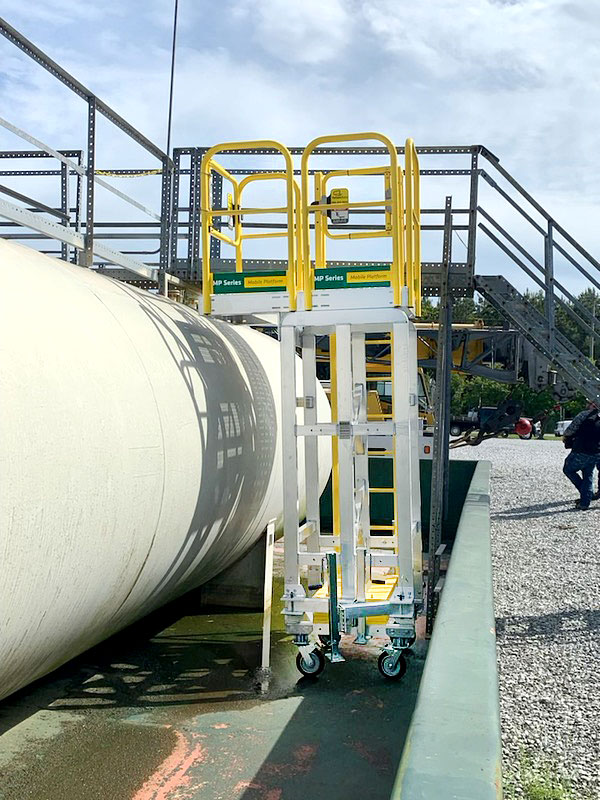Working at heights brings considerable risk for workers. When used properly, mobile ladders can be a useful way to get the job done safely. This video from the American Ladder Institute provides the important information you need to keep your workers safe while working at heights in your facility. In addition to providing high-quality fall protection and fall prevention systems, we also recommend regular safety training and routine maintenance to ensure the safety of everyone at your workplace.
Welcome to the American Ladder Institute Safety Training for mobile ladder stands and mobile ladder stand platforms. The objective of this training is to provide safe ladder practices. During this video presentation, you will be shown the proper techniques to select, inspect, use, and care for mobile ladder stands and mobile ladder stand platforms.
In this training, we will use the term “mobile ladder” to mean both of these products and the full name when commenting on one of the two products. Specifically, the safety techniques covered by this training are general to mobile ladders. Mobile ladder products vary in design and function, and please consult the manufacturer’s instructions for any questions. Mobile ladders are useful tools that, when used properly, serve as a safe system for climbing. Working at an elevated height is, however, inherently dangerous, and the safety afforded by a mobile ladder is often circumvented by misuse.
Each year over 160,000 people are injured as a result of falls from ladders due to not following proper safety procedures. Most of these injuries are cuts, bruises, and fractures, but more than 300 result in death by making a mistake while using mobile ladders can change or end your life. Properly following the techniques presented in this training will maximize your safety.
To begin, let’s examine the mobile ladder stand. A mobile ladder stand is a movable fixed-height, self-supporting ladder consisting of wide flat treads in the form of steps that give access to a top step. A mobile ladder stand is intended for use by one person; the parts comprising a mobile ladder stand include rubber pads, casters, a locking mechanism, front and back legs, and side rails. Instruction and warning labels steps, including the top step mobile ladder stands with more than five steps, are required to have handrails. Mobile ladder stands with a top step over 10 feet high and which is 20 inches or more in-depth require toe boards and mid rails on three sides of the top step.
In addition, optional accessories such as an outrigger kit are available. A mobile ladder stand platform is similar to a mobile ladder stand. A mobile ladder stand platform is a movable, fixed-height, self-supporting unit having one or more standing levels and is provided with the means of access and egress to the platform or platforms. The mobile ladder stand platform may be designed to accommodate one or more persons.
The parts comprising a mobile ladder stand platform are similar to the parts of a mobile ladder stand. The most common material used in the manufacture of mobile ladder stands and platforms is steel which is painted for corrosion protection. These products are also available in stainless steel, aluminum, and fiberglass.
Mobile ladders should only be used on a solid level surface for safe operation. Mobile ladders are available in forward or standard descending designs. Standard mobile ladder designs require that you face the ladder when descending or ascending. However, forward descent designs allow you to descend the mobile ladder facing away from it.
Lastly, mobile ladders are available fully assembled or requiring assembly. If assembly is required ensure the manufacturer’s instructions are followed explicitly.
Mobile ladder stands and mobile ladder stand platforms are manufactured in a variety of sizes and designs. To select the correct mobile ladder for a particular job, the following must be considered.
The worksite environment is the first factor in choosing the material from which the ladder is to be constructed. If the work to be done is near an open source of electricity, a metal mobile ladder should be rejected, since metal is an electrical conductor. Electrical shock while working from a mobile ladder can trigger a fall or cause your heart to stop leading to serious injury or death. In these environments, a clean, dry fiberglass mobile ladder should be used.
Next, the total weight the mobile ladder is to support must be considered. Mobile ladders are offered in various load capacities starting at a minimum of 300 pounds. When calculating the total weight and each user’s body weight plus the weight of their clothing and protective equipment and the weight of their tools and supplies. Do not assume that a taller mobile ladder has a higher weight capacity. There is no relationship between mobile ladder height and weight capacity.
Next, work height must be considered. Mobile ladders are available in various heights. The height is measured by the distance from the ground to the top step or platform mobile ladders should always be tall enough to allow you to do your job without overreaching. Overreaching increases the likelihood of losing your balance and falling from the mobile ladder.
Finally, the climbing angle of the mobile ladder must be considered where the overall footprint of the mobile ladder is not of great concern; safety and productivity can be enhanced by using models that are designed for forward descent. The key to mobile ladder safety begins with the inspection of the worksite to the end of the mobile ladder to properly inspect and secure the worksite. Check overhead for electrical hazards or obstructions to clear any clutter from where the base of the mobile ladder will be located.
Be sure the surface on which the mobile ladder is going to be placed is solid level and free of anything slippery such as water, ice, or oil block off the area around the mobile ladder to prevent being knocked from it by people or equipment. If you are working around a corner, put up signs to warn others of your presence. Mobile ladders must not be placed in front of closed doors; the door must be blocked, open, locked, or guarded. If using outdoors, be aware of environmental conditions. Same in flatbed trailers, rain, snow, and ice increase slipping hazards. Wind may cause instability while moving or using mobile letters.
Although highly durable, a mobile ladder can become damaged by improper handling, transport, impact by other objects or rolling equipment, fire, or corrosion. A thorough inspection should be made at the time of purchase, and before each use, never use a damaged mobile ladder. Begin the inspection by examining four loose, damaged, or missing parts. Start at the base of the mobile ladder, make sure the rubber pads are not broken or malfunctioning and are secured. Replace all tips or pads that are worn. Check the locking mechanism for proper functionality. According to the manufacturer’s specifications, make sure all casters are working smoothly and ensure all fasteners and bracings are tightly secured. Especially if assembly was required moving up the mobile ladder, inspect the side rails for dense cracks or bends, missing, or worn labels must be replaced, contact the manufacturer for replacement.
Along the way up the mobile ladder, check each step to ensure the step-to-rail connections are free from damage. If present, handrails, toe boards, mid-rails, and guardrails should be inspected. If the mobile ladder design includes a removable gate or chain to ensure the device is present and properly secured. All surfaces must be clean of oil, grease, and other slippery or sticky materials.
A mobile ladder that does not pass inspection but is repairable should be tagged and taken out of service. One that is no longer stable in the locked position or has a damaged side rail or damaged step should be stored away from usable mobile ladders until repaired. A mobile ladder deemed not repairable should be destroyed and replaced. Absolutely never use a damaged mobile ladder. Proper use of a mobile ladder will contribute significantly to your safety and the safety of others around you.
Common factors contributing to falls from improper mobile ladder use include haste, sudden movement, poor quality footwear, and lack of attention. Using proper use techniques will provide the mobile ladder maximum stability and ensure your safety. Follow these guidelines prior to using a mobile ladder. Always read all the manufacturer’s instructions and safety materials before attempting to use a mobile ladder to properly position a mobile ladder and roll it into the working position carefully. The ladder’s position must be on a solid level surface and located so that no overreaching is necessary. Deactivate the casters using the mobile ladders locking mechanism. Some designs require the activation of a locking device. Others are spring-loaded and require only the weight of the climber to prevent the casters from rolling.
Never use a mobile ladder with the locking mechanism disengaged. Failure to do so may result in injury or death. Before taking the first step onto the mobile ladder, make sure you’re in condition to do so. If you feel tired or dizzy or are prone to losing balance, stay off the ladder. Do not use a mobile ladder if you are impaired due to illness, drugs, alcohol, age, or physical handicap. Wear slip-resistant shoes with heavy soles to prevent foot fatigue. For maximum traction, clean your shoes of sticky or slick substances.
Always read warning labels and instruction labels prior to use, contact the equipment manufacturer with any questions, always inspect any ladder before use and remove from service any ladder with suspected damaged or missing parts. This includes rubber feet at the bottom of the ladder missing, or worn labels must be replaced. Double-check that all locking mechanisms are properly engaged. Continually face the ladder as you climb, work, or descend. Unless the mobile ladder is specifically designed for forward descent, use climb and descend slowly and avoid sudden movements.
When using a mobile ladder with handrails, always keep at least two points of contact with the mobile ladder grasping a handrail with at least one hand and keeping one foot on a step at all times. Keep clothing and body parts away from all moving mobile ladder components, including the locking mechanism. Keep the middle of your body positioned between the side rails and do not overreach or lean over the hand or guardrails. While working overreaching is one of the most common causes of ladder accidents, don’t overreach to move the mobile ladder. First, descend and fully exit the mobile ladder, then disengage the locking mechanism and relocate.
Never move a mobile ladder or disengage the locking mechanism when the ladder is in use. Do not jump or slide down from a mobile ladder or climb more than one step at a time. Never place the mobile ladder upon other objects such as boxes, barrows, scaffolds, or other unstable bases in an effort to obtain additional height. Do not use a mobile ladder in front of a door unless the door is secured in an open position locked or guarded.
Do not use a metal mobile ladder near open electrical circuits contact with an energized circuit or conductor will cause an electrical shock. Do not use on an uneven or sloping surface; units are to be used on a flat level surface. Do not stand on the stair railing, toe board, mid rails or top guardrails. Access to or egress from any staff or platform from any other elevated surface shall be prohibited. Unless the unit is equipped with a removable gate or chain and the ladder has been positively secured against any movement. Never use a mobile ladder for any purpose other than the one for which it is intended.
Now that you are familiar with proper mobile ladder selection, inspection, and use, let’s discuss how to care for the mobile ladder. To maximize the mobile ladder’s lifespan, the following techniques should be observed. Keep the mobile ladder clean, particularly a foreign matter that is conductive such substances can allow electrical current to travel over the surface of a fiberglass ladder. Protect mobile ladders from heat weather and corrosive materials. They always store and secure all ladders out of the reach of children and in high-traffic areas.
You have now been presented with the proper techniques to inspect, safely use, and care for mobile ladder stands and mobile ladder stand platforms. This concludes the presentation portion of this ladder safety training.









